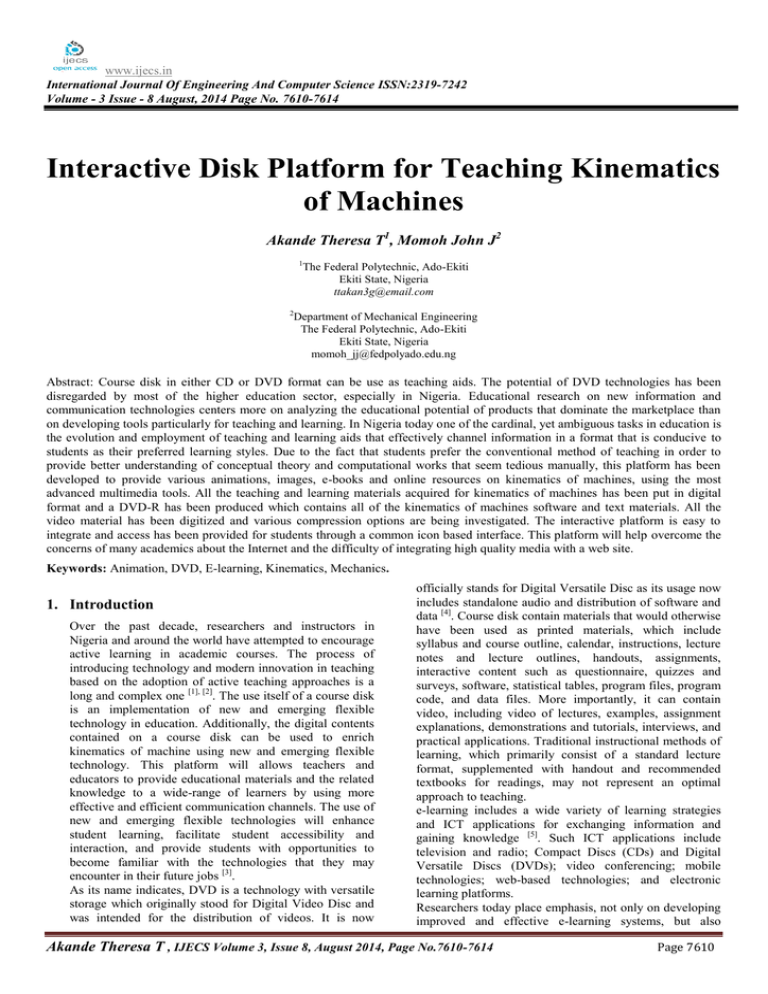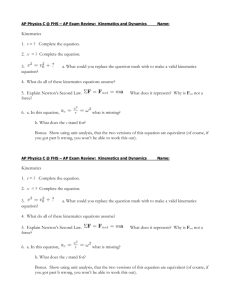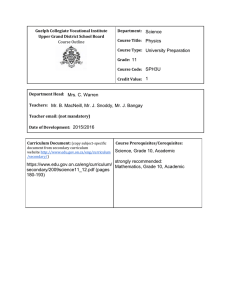www.ijecs.in International Journal Of Engineering And Computer Science ISSN:2319-7242
advertisement

www.ijecs.in International Journal Of Engineering And Computer Science ISSN:2319-7242 Volume - 3 Issue - 8 August, 2014 Page No. 7610-7614 Interactive Disk Platform for Teaching Kinematics of Machines Akande Theresa T1, Momoh John J2 1 The Federal Polytechnic, Ado-Ekiti Ekiti State, Nigeria ttakan3g@email.com 2 Department of Mechanical Engineering The Federal Polytechnic, Ado-Ekiti Ekiti State, Nigeria momoh_jj@fedpolyado.edu.ng Abstract: Course disk in either CD or DVD format can be use as teaching aids. The potential of DVD technologies has been disregarded by most of the higher education sector, especially in Nigeria. Educational research on new information and communication technologies centers more on analyzing the educational potential of products that dominate the marketplace than on developing tools particularly for teaching and learning. In Nigeria today one of the cardinal, yet ambiguous tasks in education is the evolution and employment of teaching and learning aids that effectively channel information in a format that is conducive to students as their preferred learning styles. Due to the fact that students prefer the conventional method of teaching in order to provide better understanding of conceptual theory and computational works that seem tedious manually, this platform has been developed to provide various animations, images, e-books and online resources on kinematics of machines, using the most advanced multimedia tools. All the teaching and learning materials acquired for kinematics of machines has been put in digital format and a DVD-R has been produced which contains all of the kinematics of machines software and text materials. All the video material has been digitized and various compression options are being investigated. The interactive platform is easy to integrate and access has been provided for students through a common icon based interface. This platform will help overcome the concerns of many academics about the Internet and the difficulty of integrating high quality media with a web site. Keywords: Animation, DVD, E-learning, Kinematics, Mechanics. 1. Introduction Over the past decade, researchers and instructors in Nigeria and around the world have attempted to encourage active learning in academic courses. The process of introducing technology and modern innovation in teaching based on the adoption of active teaching approaches is a long and complex one [1], [2]. The use itself of a course disk is an implementation of new and emerging flexible technology in education. Additionally, the digital contents contained on a course disk can be used to enrich kinematics of machine using new and emerging flexible technology. This platform will allows teachers and educators to provide educational materials and the related knowledge to a wide-range of learners by using more effective and efficient communication channels. The use of new and emerging flexible technologies will enhance student learning, facilitate student accessibility and interaction, and provide students with opportunities to become familiar with the technologies that they may encounter in their future jobs [3]. As its name indicates, DVD is a technology with versatile storage which originally stood for Digital Video Disc and was intended for the distribution of videos. It is now officially stands for Digital Versatile Disc as its usage now includes standalone audio and distribution of software and data [4]. Course disk contain materials that would otherwise have been used as printed materials, which include syllabus and course outline, calendar, instructions, lecture notes and lecture outlines, handouts, assignments, interactive content such as questionnaire, quizzes and surveys, software, statistical tables, program files, program code, and data files. More importantly, it can contain video, including video of lectures, examples, assignment explanations, demonstrations and tutorials, interviews, and practical applications. Traditional instructional methods of learning, which primarily consist of a standard lecture format, supplemented with handout and recommended textbooks for readings, may not represent an optimal approach to teaching. e-learning includes a wide variety of learning strategies and ICT applications for exchanging information and gaining knowledge [5]. Such ICT applications include television and radio; Compact Discs (CDs) and Digital Versatile Discs (DVDs); video conferencing; mobile technologies; web-based technologies; and electronic learning platforms. Researchers today place emphasis, not only on developing improved and effective e-learning systems, but also Akande Theresa T , IJECS Volume 3, Issue 8, August 2014, Page No.7610-7614 Page 7610 providing more advanced and interactive e-learning environments and applications that enable teachers to make technical courses such as kinematics of machines more attractive and effective for students [6]. It is important to use more effective methods and techniques to present technical problems or complex subjects as simple as possible. Interactive animations are widely used in today’s elearning systems [7]; the purpose of the interactions may be to improve active learning/practice of skills and knowledge [8] . The interactive course disk platform can be likened to “Interactive learning environments delivered via CD, Internet or LAN using a combination of text, speech, pictures, software simulations and video sequences: These products create a learn-by-doing environment that can be very effective for a motivated student. Software simulations are particularly useful in this regard” [9]. Jamis [10] in his research on analysis of the effect of learning preference on student attitudes towards the animation tutorial suggested Sensing students felt more strongly than Intuition students in regards to the interactive animation being a more effective learning modality than reading from a textbook and also presentation of content by way of computer animations and tutorials may better appeal to their learning preference. Therefore in order to make teaching more effective, different software has been developed most especially in the field of engineering to teach and analyze complex concepts like kinematics of machines. Mechanics of Machines (MEC 315) is one of the core courses in the Mechanical Engineering curriculum, as well as one of the traditional courses. Most Mechanics of Machines topics depend on geometric and physical observation, and teaching methods must enhance this ability. The use of modern teaching method to simplify the theory like multimedia, internet, simulation and animation software and visualization will enhance the conceptual understanding of the subject. Kinematics of Machines is one of the main subjects in Mechanics of Machines. The teaching of this subject has, until recently, followed the well-established topics, which involves study of properties, and graphical analysis of position, velocity, and acceleration of simple mechanisms. In the last decade, computer technology and new software tools have started making an impact on how the subject of Kinematics of Machines can be taught. 2. Development of the Platform 2.1 Generating the Animations using the GIF Animator: GIF Animator is a GIF animation editor, use as built-in image editor or any standalone graphics editor to create image files that will assemble into GIF animation. It supports JPEG, BMP, ICO, and GIF files. Examples of animation created are shown in figures 1, 2 and 3. Figure 1: The animation for a Cam and Followers saved as paint application Figure 2: The Animation for a Crank-Rocker Mechanism Saved as Paint Application Figure 3: Generating the Crank-Rocker Mechanism Animation using the GIF Animator 2.2 Analyzing Four-Bar Linkage Using Ch Mechanism The four-bar linkage is the simplest closed-loop linkage. The kinematic and dynamic analysis of four-bar linkages was carried out using the Ch Mechanism Toolkit with an output shown in figure 4 and 5. Akande Theresa T , IJECS Volume 3, Issue 8, August 2014, Page No.7610-7614 Page 7611 Kinematics of Mechanisms E-Books interface: is collection of relevant ebooks on Kinematics of Mechanism. It serves as resource materials for student. Figure 4: Crank Slider configuration The designed platform will only be use to teach kinematics of machine and related subjects like internal combustion engine, robotics, machine design and any other related courses. The results generated from successful running of the program are different animations for variety of planar mechanisms. 3 Result and Discussion Figure 7: List of relevant Textbooks The interface was designed with the aid AutoRun and Visual Basics. The AutoRun create, edit interface and generate files for CD/DVDs in a What You See Is What You Get (WYSIWYG) environment. This interface contains a library of pre-programmed instructional strategies that have been carefully designed to include the presentation, eBooks, video lecture series, and images appropriate for planar mechanism. SPLASH SCREEN INTERFACE: display the institution logo image, institution name and / or application before the application starts as shown in figure 5. Figure 8: Page opening of a Textbook Figure 5: Splash Screen Kinematics of Mechanisms Animations: This page consists of various animations on Kinematics of Mechanism. HOME PAGE INTERFACE: This page comprises various topics being explained through animation, visuals, brief definition of terms used and login into student forum. Figure 9: List of Animations on Kinematics of Mechanism Figure 6: Home Page Akande Theresa T , IJECS Volume 3, Issue 8, August 2014, Page No.7610-7614 Page 7612 agitated about this vision because it relies on new and emerging flexible technologies (interactive course disk). The use of animation and simulation software changes the way the student approach learning problems, also student find pleasure by been active in the computer exercise, they want their learning to be interactive, student-oriented, authentic, collaborative and ondemand. To get the best benefit of the selected package, it must be easy to learn and can be used for more than one course. 5. Recommendations Figure 10: Animations of Crank-Rocker Mechanism Kinematics of Mechanisms Video Lecture Series: this page contains videos where the student’s can see and hear explanations from renowned scholars, providing a comfortable and flexible training experience. This research is a technological improvement, even in the developed countries, the traditional way of teaching has been considered obsolete and therefore not in practice. The innovation of computer has brought a change to every way of living. So it is time for Nigeria educational system, to adopt this new way of teaching by using new and emerging flexible technology in the higher institution of learning to enhance better understanding of the mechanism-based courses. Since the understanding of the mechanism related courses can be enhanced using this E-learning Platform, we thereby recommend the E-learning Platform for both lecturers and students studying any course on planar mechanism. The project only focused on kinematic of machines, more work can still be done on other type of mechanism and aspects of mechanics of machines, that is spatial mechanism and other mechanisms yet to be studied, even other fields of Mechanical Engineering. Acknowledgements This work would not have been possible without the steadfast support of TETFund. Acknowledging the Tertiary Education Trust Fund (TETFund), Management of the Federal Polytechnic, Ado-Ekiti and Polytechnic Research Committee for the privilege given by funding a research titled “Development of a Computer-Aided Interactive Learning Platform for a Planar Mechanism (CAILPPM)” through which knowledge on the use of most of the software were gotten. The research was an eye opener for which it could be adopted in many other area of study. Figure 10: List of Kinematics of Mechanism Lectures References [1] [2] [3] [4] Figure 11: Kinematics of Mechanism Lectures 4. Conclusion This presentation demonstrates a vision for leveraging underutilized features of interactive course disk as new and emerging flexible technology of interactive educational materials for students taken Kinematics of Machines as a course. We are Pundak D, Maharshak A, Rozner S (2004). Successful pedagogy with web assignments checker, J. Educ. Technol. Syst. 33(1):67-80 Dori YJ, Herscovitz O (2005). Case-based longterm professional development of science teachers, Int. J. Sci. Educ. 27(12):1413-1446. Chance, B., Ben-Zvi, D., Garfield, J., and Medina, E. (2007), ―The Role of Technology in Improving Student Learning of Statistics,‖ Technology Innovations in Statistics Education, 1(1). (http://escholarship.org/uc/item/8sd2t4rr) Greenberg, J (2001). A Hybrid System for Delivering Web Based Distance Learning and Teaching Material, The Open University, EUNIS Proceeding, Humboldt University, Berlin: Retrieved November 20, 2013 from https://edoc.huberlin.de/conferences/eunis2001/d/Greenberg/HT ML/ Akande Theresa T , IJECS Volume 3, Issue 8, August 2014, Page No.7610-7614 Page 7613 [5] Sife, A. S; Lwoga, E. T and Sanga, C., (2007). New technologies for teaching and learning: Challenges for higher learning institutions in developing countries, International Journal of Education and Development using Information and Communication Technology (IJEDICT), Vol. 3, Issue 2, pp. 57-67. Retrieved November 20, 2013 from ijedict.dec.uwi.edu/include/getdoc.php?id=2385& article=246...pdf [6] Omer, D., Utku, K. & Ramazan, Y., (2012). Design and Development of an E-Learning Environment for the Course of Electrical Circuit Analysis Interdisciplinary Journal of E-Learning and Learning Objects, Volume 8, [7] Garrison, R. D., & Kanuka, H. (2004). Blended Learning: Uncovering its Transformative Potential in Higher Education. The Internet and Higher Education, 7, 95-105. [8] Kuhlmann, T., (2010). The Insider’s Guide to Becoming a Rapid E-Learning Pro: www.articulate.com/rapid-elearning. Accessed July 17, 2013. [9] SchoolNet Africa, (2004). Towards a Strategy on Developing African Teacher Capacities in the use of Information and Communication Technology (ICT). Retrieved March 29, 2014 from http://www.col.org/PublicationDocuments/pub_04 Towards_Strategy_Africa.pdf [10] Jamis, J. P. (2010). The Benefits of Using a Course Disk to Aid in the Instruction of Statistics Courses. Journal of Statistics Education, Volume 18, Number 3. Retrieved November 20, 2013 from http://www.amstat.org/publications/jse/v18n3/perr ett.pdf Akande Theresa T , IJECS Volume 3, Issue 8, August 2014, Page No.7610-7614 Page 7614




